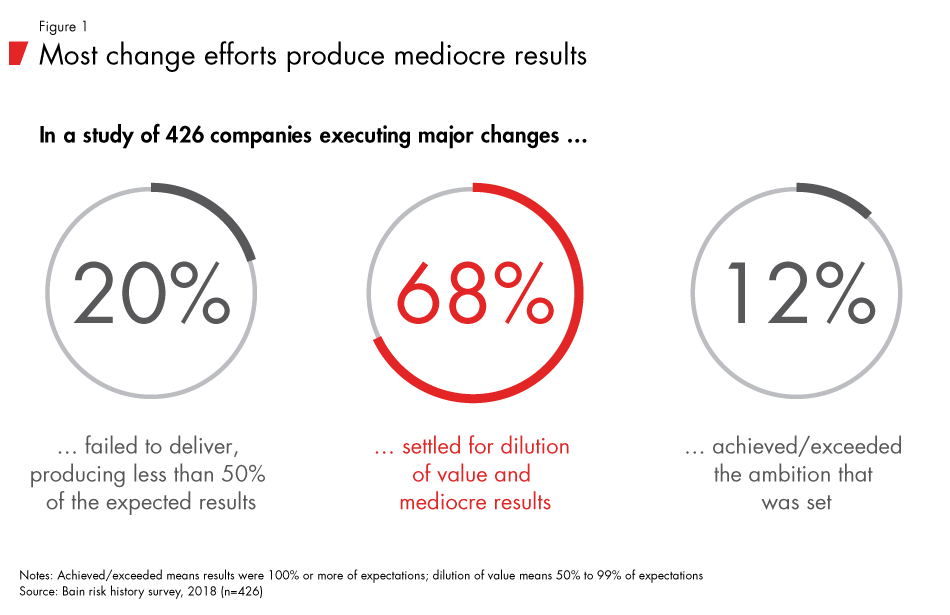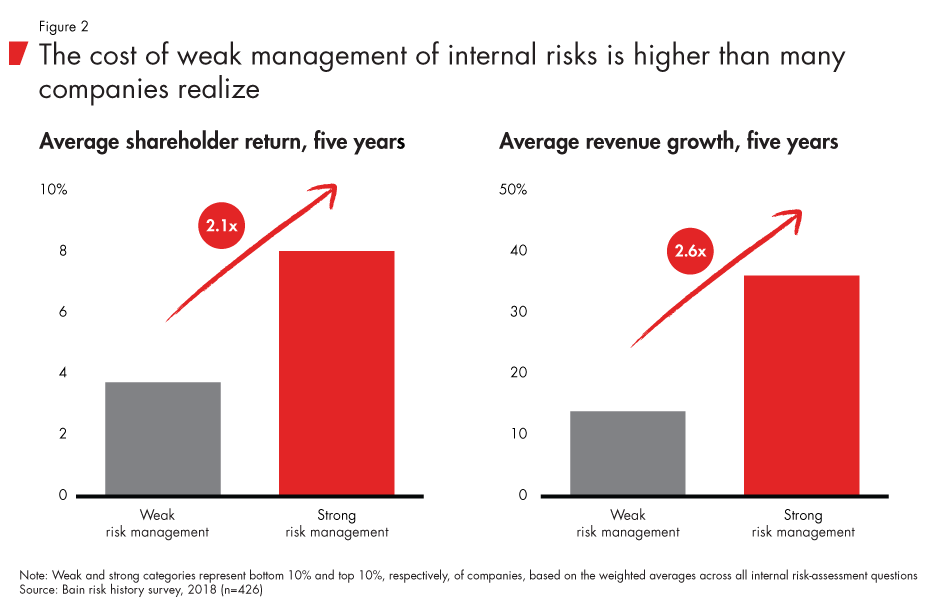Brief
 }
}
At a Glance
- Contrary to popular belief, transformations rarely fail outright, they underperform.
- This pattern of mediocre performance costs more than most leaders realize.
- Bain research shows that skillful management of internal risk accounts for 80% of success.
- Companies that reach their transformation goals engage the organization in the change process early on.
Going around the table, each member of the executive committee agreed that the firm's plan to transform its multibillion-dollar retail business was ready to roll. It was make or break, and the organization's people would determine the difference. The leadership team members thought they knew about the risks that could derail change. "We've got it covered,” affirmed the chief transformation officer. But embedded in the work plans was a disaster waiting to happen: The bulk of the investments and resources were set up to manage things like costs, competitor moves and supplier relationships—the outside forces that can't be overlooked, but also can't compensate for winning the all-important inside game. Missing was a strong commitment to managing internal execution risks. That meant another transformation would fall short.
Every year, companies spend billions of dollars on business transformations, and yet few do it well. Only 12% of companies achieve their full transformation targets—the same number as five years ago, according to a recent Bain survey of senior executives who have led large-scale change programs. By their own admission, the vast majority say their results are mediocre: 68% settle for value dilution, achieving more than half of their stated goals, but falling well short of their ambition. The good news is, the share of total failures—companies that missed their ambition by a wide margin—dropped sharply to 20% from 38% in 2013 (see Figure 1).
Conventional wisdom says that most transformations fail. The truth is, companies are learning how to avoid complete failure, but most haven't figured out how to succeed. Winning the outer game of cost, competitive position and strategy is vital. But no matter how brilliant a company's business choices, the inner game determines whether a transformation will succeed. When leadership teams plunge forward without investing sufficient time and resources to manage all the related risks, transformations stall out. The 426 leaders we surveyed reported that steering change effectively inside the company had a tremendous impact on reaching their goals. In fact, leaders who achieved or exceeded their transformation targets said inner-game factors made up 80% of the reasons for their success.
A well-executed transformation can produce extraordinary results, lifting the energy and confidence of an entire organization. CEOs who have led successful change efforts know the biggest challenge is endurance. Like rally car drivers setting off on a trek across Africa, they make sure the organization has enough gas on board when it sets off, and they keep an eye on the gauge along the way, boosting the organization's energy reserves by mobilizing people and sustaining their commitment.

The high cost of mediocrity
Business transformations usually start out with a burst of energy. At some point, however, fatigue sets in and the transformation enters the "valley of death” (see the Bain article "Reenergize Change Programs to Escape the ‘Valley of Death'"). People who were excited about making the transformation happen grow tired of the extra work and impatient with the lack of visible results. Those who were reluctant at the outset feel vindicated and escalate their resistance. Commitment gives way to cynicism. Most often, change programs that enter the valley of death never fully emerge from it. They either fail outright or produce mediocre results.
In our experience, the cost of a mediocre outcome is higher than most leadership teams realize. Even a relatively minor miss on things like margin targets compounds over time, and can cause the business to fall far short of its goals and disappoint investors. For the weakest companies, the gap can be formidable. Five years after launching a transformation, average shareholder returns for companies that managed internal risks well were more than two times higher than for those in the bottom 10%, Bain research shows (see Figure 2).

Even more damaging, derailed transformations puncture the credibility of the management team and sow confusion across the organization. Often, companies seek to camouflage disappointing results by scaling back their ambitions and recasting initial targets as stretch goals. Revising the story line, however, just widens the credibility gulf. The next time the company embarks on a change effort, the rhetoric sounds empty.
The loss of credibility triggered by a lackluster transformation is a blind spot for many leadership teams. It's also one reason why trust in CEOs is at a record low. Take the case of one global industrial company, which set out to transform its business through new products, an automated production line and a move to shared services. Initial results exceeded targets, but after 18 months—the dangerous moment when big transformations typically falter—its CEO shifted all his attention to resolving short-term pressure on earnings. Without top management focus, the change effort floundered, denting the CEO's reputation and leaving the organization in upheaval. By the third year, instead of an expected improvement in the fi rm's employee Net Promoter Score®, a widely used indicator of employee loyalty and enthusiasm, the rating had plunged 60 percentage points to negative 17.
Patrick Litré, the global leader of Bain’s Results Delivery® practice, describes how managing execution risks within the company can prevent transformations from stalling.
Mastering the inside game
Leaders who have mastered the inner game acknowledge a simple truth: People struggle with change. Successful leaders build deep commitment at all levels of the organization from the outset, acquire the capability to encourage behavior change, ensure fast governance and inspire the organization with a clear vision of the company's future state. They also prepare for the valley of death—the difficult phase of sustaining change after the initial enthusiasm disappears. Bain research shows leadership teams that address these inside risks are nearly two times more likely to achieve their ambitions and three times more likely to sustain change.
Amgen Chief Executive Robert A. Bradway led his company through a successful multiyear transformation by anticipating the hazards that could derail the effort. Long before the transformation got under way, Bradway spent months discussing key risks with his leadership team and in a sign of commitment, appointed a trusted senior executive, Brian McNamee, as chief transformation officer in 2013. McNamee set up an extensive feedback loop to measure progress, allowing the company to adjust the plan every four to six months and each initiative monthly. He also deployed a "change-agent network,” a group of trusted leaders in the field, to understand how the transformation was affecting the organization. The leadership team listened to frontline managers' concerns and advice, building credibility in the process.
Amgen's upfront efforts to help people understand the transformation supported the momentum for change even when people's energy inevitably flagged at the midway point. After two years, the company's margins had risen by 15 points and the stock price had doubled. Support for the company and the CEO predictably dipped one year into the effort, but at two years, it had rebounded to a level higher than at the beginning of the transformation. Bradway's Glassdoor CEO approval rating rose 12 percentage points in the same period (data provided by Glassdoor). His current rating is 76%.
Get an early start
Despite the thousands of books published on managing change, leading a successful transformation remains an elusive goal for most leadership teams. How can companies start to improve their inner game? Bain research shows the most critical factor is getting an early start building commitment throughout the organization. That finding makes sense, given the widespread shift to a more collaborative management culture—the No. 1 trend in Bain's 2018 Management Tools and Trends survey. Nearly 80% of executives say today's business leaders must "trust and empower people, not command and control them.”
But communication alone does not create engagement. In our experience, many leadership teams are disconnected from their own people's thinking. They assume that explaining the rationale for a business transformation will convince people it's needed. Many fail to realize that their perspective is based on data, insights and management discussions that haven't been shared with employees.
Leadership teams that launch a transformation without engaging their own people in dialogue and giving them time to embrace the logic themselves are less likely to succeed. Winning the inner game starts with making sure people participate in the change and provide regular input, so it's not done to them, but with them. Co-involvement in the transformation process infuses managers and the front line with energy to implement change and sustain it. Leaders say that approach doubles their chances of success.
Soon after Chief Executive Kevin Lobo took the helm at Stryker Corp. in 2012, he set out on a multiyear transformation to improve the Kalamazoo, Michigan, company's global reach and performance. His first step, shifting from a decentralized US operating model to a more coordinated transatlantic model, meant changing deeply rooted ways of working. Knowing that the fate of the change effort depended on Stryker's people, Lobo and his executive team dedicated the first three months to "listen-and-learn tours” across regions and business units, to hear firsthand thoughts, concerns and ideas from the field.
Open dialogue created trust and commitment. The next step was a series of highly interactive workshops, deliberately mixing people from different functions and geographies who needed to work closely together. The workshops, called "a seat at the table,” helped build a strong sense of ownership in the new operating model and strengthen personal relationships. Two and a half years after the program kickoff, the company exceeded its target for accelerated growth in Europe, the Middle East and Africa: Stryker's compound annual growth rate for net sales in the region jumped fourfold to 10%. The broader, multiyear transformation contributed to a tripling of the company's enterprise value, creating roughly $40 billion in market capitalization since 2012.
Learning to succeed
Although only 12% of companies make good on their transformation goals, there's a proven path for others to replicate their success. Leaders invest the time and resources to understand how change is likely to disrupt the organization and who will be hit hardest. In particular, they discuss the critical internal factors that can derail change, and take steps to mitigate the risks. To ensure the organization is committed to a transformation, they listen closely to the individuals who will bear the brunt of change. When pain grips the organization at the halfway point, CEOs play a critical role sustaining the effort. They redouble their commitment and work to restore people's faith in the promises they made. Mastering the inside game helps these leaders beat the odds and deliver successful transformations.
Patrick Litré is a partner in Bain & Company's Atlanta office and a leader in the company's Results Delivery® and Transformation practices. David Michels is a partner in Bain's Zürich office and a leader in the Results Delivery and Transformation practices in Europe, the Middle East and Africa. Sebastian Walter is an expert vice president in the Results Delivery and Transformation practices in Bain's Berlin office. Melissa Burke is the practice director of the Global Results Delivery practice, and is based in Atlanta.
Net Promoter Score®, Net Promoter System®, Net Promoter® and NPS® are registered trademarks of Bain & Company, Inc., Fred Reichheld and Satmetrix Systems, Inc.

